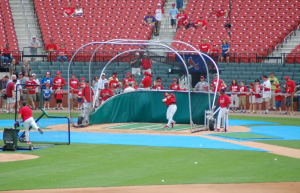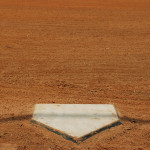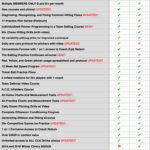CCA Podcast 123 – 10 tips for a more efficient batting practice
Podcast: Play in new window | Download | Embed
Subscribe: RSS
 In this episode of the CCA Podcast, you will learn:
In this episode of the CCA Podcast, you will learn:
- How to set up a routine for your players and why it's important
- How to make sure their swings count toward their 10,000 hours of "deliberate practice"
- How to use batting practice to emphasize your hitting philosophy
- Should players get a set number of swings, or a set number of pitches, and why.
- How to work bunting into your batting practice routine
- What we renamed our batting practice sessions to make them more productive
Resources of the show
-
Batting practice template - Print out this template, fill in your player's names and you have a great routine to minimize transition time and maximize production.
-
5 hitting drills that translate to game performance - There are TONS of hitting drills out there that look great in practice, but don't do a darn thing to create better hitters. Here are 5 great ones totally FREE!!!
-
3 part series on hitting in the Statcast era- In this presentation in our Winter Clinic, I break down what Statcast data means for you and how you can use it to your advantage.
-
Week long batting practice plans - Elite members have access to week long batting practice plans that include on field drills, cage drills, tee work, and bunting drills all planned out for you.
-
Chaos hitting drills - Simulate the game the best way we can in practice with these drills.
10 ways to maximize on field batting practice
There is no part of practice that players love more than batting practice, especially on field batting practice. But, from a coach's perspective, this is the part of practice that has a tendency to be the least productive and if you’ve followed me for any period of time, you know there is nothing I hate more than unproductive practice time!
Here a 10 great tips to help you get the MOST out of your on field batting practice sessions.
1. Have a pre-set routine so no time is wasted in set up or rotations.
Start with the same group in the same spot each day. Assign kids the same roles in getting set up and tearing down the field. Whether you are in the cage, or on the field, you will need someone to take care of baseballs, L-screens, nets, your side hitting stations if you set them up. Have players take care of the same stations during tear down.
We have a portable batting cage that needs to be brought from outside the field into the field and around home plate each time we hit on the field. The most prestigious job on our team is “driving” the portable backstop.
You can get our on field batting practice template by going to:
2.) Don’t just let players mindlessly swing. Have a specific goal for each station, round, and swing.
Becoming an expert performer takes 10,000 hours of “deliberate practice.” Taking 10 swings off a tee, or hitting 10 pitches in the cage don’t qualify as deliberate practice.
Coaches can help this process by being organized ahead of time and having a plan for every round, every pitch, and every station. Players will gravitate toward mindless swings if coaches let them, so it is important that you are engaged as your batting practice session goes on and they are redirecting hitters as much for their focus, purpose and intent as they do for their swing.
For some extra ideas, here are 5 great drills to give players focus in batting practice and have them making decisions before swinging: www.cornerstonecoachingacademy.com/5-drills/
3.) Emphasize pitch selection during batting practice. When else do they get to work on it?
Early in my coaching career, I made pitch selection and approach at the plate a point of emphasis in all of my post game talks, and in all of the scolding I did of my hitters. The problem was, I didn’t make it a point of emphasis in our practices and batting practice.
It is incredibly unfair to ask players to perform something in a game that you don’t let them, or make them work on in practice. Imagine a math teacher giving a calculus test to an algebra student without teaching them any calculus.
So I started to come up with different ways to have hitters work on pitch selection in practice.
The most obvious and simple method is to have players identify good pitches to hit and bad pitches to hit, then encourage them to hit the good pitches and let the bad pitches go.
Be sure to explain to your hitters that with less than two strikes, not all strikes are good pitches to hit, but all good pitches to hit are strikes.
A more advanced approach is to put your players in specific counts for each pitch and teach them a specific approach for each.
4. Give players a set number of swings, not a set number of pitches during their round
One of the biggest mistakes I made as a young coach during our on field batting practice rounds was giving players a set number of pitches, not a set number of swings.
Again, this goes back to making sure players are practicing pitch selection during batting practice. If they have a set number of pitches, you’d better believe they’re swinging at everything. But if you give them a set number of swings, you’d better believe they’ll be selective!
5. Set up specific hitting drills off to the side of your field or in your cage
In addition to hitting on the main field, we send a group to the batting cage down the left field line to work on specific drills, and we set up a sock net behind the on field batting cage for the group hitting on the main field to work on. This keeps more players working, more players active, and more players involved at all times while giving them specific goals and skills to work on.
You can have those drills relate to what you are doing on the field that day. For example, if you are working on a two strike approach, it would be beneficial to work on an outside tee drill as a supplement. If you are working on plus counts (1-0, 2-0, 2-1, 3-1) you could put a radar gun down and let hitters test their off the bat velocity on your side drills.
6. Set up a bunting station right before players hit on the field.
Bunting is a great way to learn how to track the baseball. Put your bunting station off to the side right before a player gets into the on field cage accomplishes two things. It helps players start tracking the ball, and it gives bunting its own focus.
If you put your bunting on the field, many players will view it as a distraction before they get to the main show!
7. Have a coach or extra players hitting ground balls to infielders between pitches
In between each pitch, have a coach or extra player hit ground balls to your infielders.
Wherever the ball is hit off the bat, the group of defenders in that area will play the ball live. The other infielders will look toward their fungo hitters for a ground ball.
Timing is the most difficult thing to get with extra fungo hitters. The rule of thumb is for the fungo hitter to hit the ground ball as soon as he sees that the ball off the hitter’s bat isn’t hit to the infielder he was going to hit it to. This will ensure that you’re not waiting for the infielder to finish fielding the ball before the batting practice pitcher can deliver.
8. Have players work on base running after they finish their round in the main field cage
After their round in the cage, have the hitter work on base running. You can have runners off first work on a hit and run. When they get to second, they can work on reading balls off the bat with less than two outs, and from third base, they can work on scoring with less than two outs.
9.) Require your defensive players to be in their positions and to work on fielding the ball liv off the bat.
We have actually changed the name of our on field batting practice to "live defensive practice” to shift the focus from the hitters to the fielders.
No matter what you do, when you hit on the field, the hitter will be locked in. There’s nothing baseball players like more than hitting batting practice on the field. It’s the fielders who will take some coaxing that this is their most important time as well.
It is particularly important for outfielders to be able to get live reads off the bats. The difference between a fungo and live ground ball is minimal, but the difference between a fungo and live fly ball is substantial.
There is no better time for your outfielders to learn how to get jumps and communicate on fly balls than when the ball comes off the bat live. They don’t need to run down every single fly ball off the bat, but they do need to work on getting as many jumps as they can, and they do need to communicate when they
To that end, it is also important not to have “floaters” in the outfield. We line up players at each of the three outfield positions and have nobody else between them so they get realistic reads, jumps, and traffic to the ball.
10. Work on your two strike approach
Everyone likes to have success in batting practice and in the cage, but the game isn’t all sunshine and rainbows. Hitting with two strikes is the most difficult thing hitters will do in the game, and it can be what separates average from good, and good from great hitters.
It is possible to work on two strike approach in batting practice and in the cage without destroying a player’s confidence. We just need to redefine what success is.
With less than two strikes, success is getting a good pitch to hit and hitting it hard. With two strikes success is anything that doesn’t result in a strike out. So a foul ball, taking a ball, or any ball put in play is a win for that hitter.
Redefining success this way helps keep confidence up while working the most difficult part of hitting.
11. BONUS TIP!!! Have enough baseballs so you aren’t spending extra time collecting them.
One of my biggest pet peeves is wasted time. A sure way to waste time is to have too few baseballs.
We combat this by making sure we purchase enough baseballs at the beginning of the season (usually about 20 dozen practice balls) and more than enough buckets.
We put two empty buckets behind a net in short center field with a “shagger” who is usually an extra pitcher, and injured player, or an extra catcher. Our batting practice pitcher will have two buckets filled with out batting practice baseballs behind the L-Screen.
Every time a coach runs out of one of the buckets of baseballs, the shagger runs in (between hitters or groups obviously) to fill the coach’s empty bucket. Having that extra bucket full ensures that if there is lag time between when the first bucket empties and the shagger is able to get to the coach throwing BP, you won’t run out of baseballs and have to grind the whole process to a halt.
Conclusion
On field batting practice is fun for players, but if it isn’t organized properly, it will be horribly unproductive.
Implementing these tips in your batting practice sessions will ensure that your entire team benefits from this session, allows you to work on multiple aspects of the game at once, keeps all players involved, and forces hitters and fielders to work on game situations.
More from my site
 Taking a Good Approach at the Plate
Taking a Good Approach at the Plate CCA Podcast 071: Part 2 of 3 of playing great team defense
CCA Podcast 071: Part 2 of 3 of playing great team defense Mini – Why the player making more errors may be the better defender
Mini – Why the player making more errors may be the better defender Mini – Red, Yellow, Green Pitcher Throwing Program
Mini – Red, Yellow, Green Pitcher Throwing Program CCA Podcast 246 – Getting pitchers ready for opening day
CCA Podcast 246 – Getting pitchers ready for opening day Mini – Catcher Responsibilities During Bullpens
Mini – Catcher Responsibilities During Bullpens
 Posted by Kyle Nelson
Posted by Kyle Nelson- Posted in Hitting
 Feb, 05, 2018
Feb, 05, 2018 No Comments.
No Comments.
Elite members login here
Check out what’s New/Hot!
Recognizing, Diagnosing, and Fixing Common Hitting Flaws eCourse The 3 metrics we tested on Blast motion sensors this year Sneak Peek Inside an Elite Q and A The batting practice continuum Elite Member’s area table of contents 50+ “Chaos” hitting drills
5 sample Chaos hitting drills FREE
Mental Skills and Culture Building The hitting pyramid Welcome Elite Member, Trey! Ideas for a pitcher first practice 12 week bat speed improvement plan Make plans this offseason to have your team playing their best baseball at the end of the year” Top 5 hitting drills to translate practice skill to game performanceHow we used Blast Motion sensors with a team in 2019
What to do if your hitters are overmatched Welcome Elite Member, Tommy! Setting your baserunners up for success Welcome Elite Member, Mike! A consulting call with Elite Member Matt FREE Web Clinic: Developing Athletic, Consistent, Extraordinary Infielders
 Coach Kyle Nelson
Coach Kyle Nelson